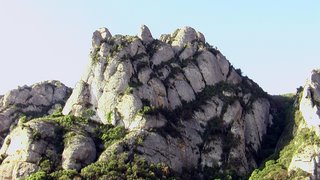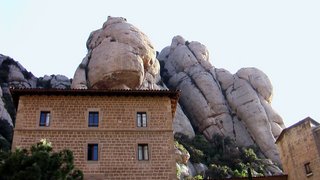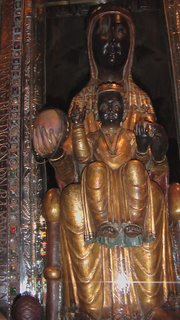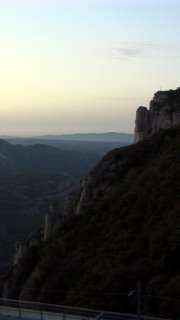 To resume my "travelogue," we must go to Montserrat. I got my first glimpse of this venerated mountain as we were driving out of Barcelona. My seat faced backwards, so I could see the towers of Sagrada Familia, and some time later, taking in the terrain, I noticed the oddest sort of mountain. It was towering and bald, but with smooth, vertical reaches. In fact, it was so unusual I took some video footage of it to show the sisters back home. Little did I know that it was our destination! But after we left Manresa, we began and upward climb that seemed to last forever. Barbara had already begun making smart remarks about Ignatius' staying in his office in Rome, so Karen and I made sure to point out how difficult a road this must have been for someone with a crippled leg (even though at the time, Iñigo had a donkey--he would leave it at the monastery). In fact, Montserrat is a popular destination not just for pilgrims, but for hikers and rock climbers--and Sunday is the big day. (Frankly, I can't see making that huge ascent just for a day trip.) We continued rounding the steep hill, barely seeming to have a foothold, as we went higher and higher, until the valley below seemed more like a mirage than a place we had actually been ourselves not that long before. We even wondered if we could possibly be in the right place: could there really be a monastery beyond us? Was there anything up there but rock and trees and sky?
To resume my "travelogue," we must go to Montserrat. I got my first glimpse of this venerated mountain as we were driving out of Barcelona. My seat faced backwards, so I could see the towers of Sagrada Familia, and some time later, taking in the terrain, I noticed the oddest sort of mountain. It was towering and bald, but with smooth, vertical reaches. In fact, it was so unusual I took some video footage of it to show the sisters back home. Little did I know that it was our destination! But after we left Manresa, we began and upward climb that seemed to last forever. Barbara had already begun making smart remarks about Ignatius' staying in his office in Rome, so Karen and I made sure to point out how difficult a road this must have been for someone with a crippled leg (even though at the time, Iñigo had a donkey--he would leave it at the monastery). In fact, Montserrat is a popular destination not just for pilgrims, but for hikers and rock climbers--and Sunday is the big day. (Frankly, I can't see making that huge ascent just for a day trip.) We continued rounding the steep hill, barely seeming to have a foothold, as we went higher and higher, until the valley below seemed more like a mirage than a place we had actually been ourselves not that long before. We even wondered if we could possibly be in the right place: could there really be a monastery beyond us? Was there anything up there but rock and trees and sky? There was.
 The monastery is an ancient one--Montserrat has been a "holy place" since time immemorial, so it was natural for the Benedictines to establish a house there. It is built into the raw mountainside, a place of refuge and a popular Marian shrine. It was here that our pilgrim had "determined on a watch of arms throughout the whole night...before the altar of Our Lady of Montserrat," and here "he arranged...to have his sword and dagger hung in the church at the altar of our Lady."
The monastery is an ancient one--Montserrat has been a "holy place" since time immemorial, so it was natural for the Benedictines to establish a house there. It is built into the raw mountainside, a place of refuge and a popular Marian shrine. It was here that our pilgrim had "determined on a watch of arms throughout the whole night...before the altar of Our Lady of Montserrat," and here "he arranged...to have his sword and dagger hung in the church at the altar of our Lady." We had reservations for the on-site pilgrims' hotel, and our accommodations were lovely. From my window, I could look out on the strangely "serrated" mountains that give the region its name. The huge bells echoed the hours--you can hear the bells on the Shrine's website. We were able to attend Mass in the side Blessed Sacrament chapel. It was a tight squeeze, but a real blessing. (Remember, Karen had been pretty ill that morning, but she didn't want to miss Sunday Mass.) The chapel was bare, except for a modern (not entirely devotion-inspiring) crucifix. (At least, I think it was a crucifix of some sort... my memory could be fading.)
The visitors' area has a large cafeteria, but it was closing by the time we got there (we barely had time to buy the bottled water we needed). The gift shop is immense. I found a pretty one-decade rosary that was just right to bring to  the staff, plus a book about the shrine. Karen found many wonderful things, including previous, finely carved wooden statues of Our Lady of Montserrat which she gave to me and Barbara. (Mine is now on my little altar, with a first-class relic of St. Ignatius at her feet.) The hostel basement-level restaurant was also picturesque, and the food was delicious, even though the service that first night was so slow we thought we had done something terribly offensive to the wait-staff.
the staff, plus a book about the shrine. Karen found many wonderful things, including previous, finely carved wooden statues of Our Lady of Montserrat which she gave to me and Barbara. (Mine is now on my little altar, with a first-class relic of St. Ignatius at her feet.) The hostel basement-level restaurant was also picturesque, and the food was delicious, even though the service that first night was so slow we thought we had done something terribly offensive to the wait-staff.
 the staff, plus a book about the shrine. Karen found many wonderful things, including previous, finely carved wooden statues of Our Lady of Montserrat which she gave to me and Barbara. (Mine is now on my little altar, with a first-class relic of St. Ignatius at her feet.) The hostel basement-level restaurant was also picturesque, and the food was delicious, even though the service that first night was so slow we thought we had done something terribly offensive to the wait-staff.
the staff, plus a book about the shrine. Karen found many wonderful things, including previous, finely carved wooden statues of Our Lady of Montserrat which she gave to me and Barbara. (Mine is now on my little altar, with a first-class relic of St. Ignatius at her feet.) The hostel basement-level restaurant was also picturesque, and the food was delicious, even though the service that first night was so slow we thought we had done something terribly offensive to the wait-staff. The statue of Mary that is venerated at Montserrat is one of Europe's "Black Madonnas." It is a romanesque statue, very stately, with Mary seated on a bench-like throne, holding Jesus in her lap. Her right hand is extended, holding a globe, and the left is also somewhat extended, as if designed to hold a taper. Now the statue is surrounded with plexiglas--all but the fingers of Mary's right hand, and part of the globe. Visitors climb a marble staircase (with an arched ceiling entirely covered in gold mosaic) behind the principal altar to venerate the statue. Traditionally, this is where newly married couples came to entrust their married lives to Mary, and women came to pray for safe childbirth. While I was waiting for my turn, just a few steps from the statue, I watched a Spanish family (Mom, Dad, four children and Grandpa) go before Mary. The youngest child was barely a year old, and his mother put his little head near Mary, to kiss her hand. Then Grandpa took the camera and the family posed with Mary for a picture. It was just too charming!
As remote as it was, Montserrat was not spared pillage. We did not see the shrine and monastery Ignatius would have known, and which (it seems) he came to on a regular basis for spiritual direction while living at Manresa. These were destroyed by the French army. This was not the last desecration. During the Spanish Civil War, the statue of the Virgin was hidden away safely, but the monks were martyred. It is hard to know how much of what we saw was actually a restoration--probably most of it. The mosaics in the area around our Lady's statue are of 20th century provenance (attractive, but definitely contemporary), and the side chapels have that barrenness that testifies to earlier desecration, but the entire shrine church itself is spectacular. (There is simply no other word for it.) There is a boys' choir and choir school, which I didn't really know about until too late--although by Divine Providence, I went into church to make a visit just as this famous choir was singing a final  hymn. (They were spectacular, too.) I made three visits to our Lady's statue, and each time I discreetly tried to take pictures. Only the ones I took with Karen's camera really came out well. Happily, one of these is of a stained-glass window right outside the Chapel of the Virgin. It depicts Iñigo the Pilgrim. (Thank you, Karen--again!)
hymn. (They were spectacular, too.) I made three visits to our Lady's statue, and each time I discreetly tried to take pictures. Only the ones I took with Karen's camera really came out well. Happily, one of these is of a stained-glass window right outside the Chapel of the Virgin. It depicts Iñigo the Pilgrim. (Thank you, Karen--again!)
 hymn. (They were spectacular, too.) I made three visits to our Lady's statue, and each time I discreetly tried to take pictures. Only the ones I took with Karen's camera really came out well. Happily, one of these is of a stained-glass window right outside the Chapel of the Virgin. It depicts Iñigo the Pilgrim. (Thank you, Karen--again!)
hymn. (They were spectacular, too.) I made three visits to our Lady's statue, and each time I discreetly tried to take pictures. Only the ones I took with Karen's camera really came out well. Happily, one of these is of a stained-glass window right outside the Chapel of the Virgin. It depicts Iñigo the Pilgrim. (Thank you, Karen--again!)We stayed in Montserrat only until mid-morning, so all of us tried to get up as early as possible, in order to benefit as much as possible from the remarkable location. Karen delivered her camera over to me and I went crazy taking pictures of the scenery and the architecture, and then, when I could do it without scandalizing anyone, of the Virgin (and of that stained glass window!). (I can see Karen plowing through all the images on her memory card: what's with all these gargoyles? all these facade pictures? doorways? arches?)
But on Monday we had other plans. Monday was to be the day of two castles. One was at a place called Javier, or, in the local Euskadi language, Xavier.

No comments:
Post a Comment